Posts in Category: Tools
Making a new backsaw handle
When I was working down in the garage last week I noticed that my Disston backsaw handle had cracked even further. I picked it up at a antique store a while back, rusty and beaten down (but not out). I had revived the blade, and it has become a staple in the shop for mid level sawing. Tonight I made a new handle for this saw, my bench top workhorse of a saw. In three hours no less!
Christopher Schwarz might say Medium in the Coarse Medium and Fine scale, at least I think that’s what it implies as I’ve not picked up the book yet. It’s a concept I get though once I thought about, grouping tools into ones that handle the coarse, the medium and the fine.
Anyway, I got a little time tonight to work in the shop and rather than work on the project I had started last week, I decided to pick up a new project. When I get time, I tend to go with the flow, almost Zenlike if you will, although I think Zen might require less swearing and dropped tools. I picked up the backsaw to move it out of my way, and noticed the handle split again.
I picked up a random piece of scrap wood I had salvaged from the 2nd Use store, Walnut I think, and traced my old handle on the board. I sketched the busted off bottom horn by putting on of my Disston handsaws down, and making it fit. Then I tweaked it a little to make the whole think look right.
To make the cut outs and make the inner curves I tried a trick I read on a blog somewhere, and used a number 12 and number 16 auger bit to make the really tight curves of the inner handle and under the horns in the back of the handle. I cranked these up in my brace and bit (is it just a brace?) and did one side till the lead screw poked out the other side, and then flipped it over to get a clean hole with no tear out.
Then I cut out whole thing using a coping saw mostly with some straight cuts with my crosscut or dovetail saw. (Coarse and Fine, but really it was whatever worked and was handy.) I tried to stay as close to my pencil lines as I could. The auger holes were a HUGE help and really made this much easier. I highly recommend this approach when making a saw handle like this.
Then it was time for lots of file work. This is what took most of the three hours, mostly with a coarse toothed rasp that had a round and a flat side. I kept referring back to the original handle as to where to shape, and lots of test fitting to my hand and adjusting and filing, etc. I broke a pretty fair sweat on this part, but it was fun to have it becomes slowly become more and more comfortable in my hand. I tuned it up with a finer rasp, and finally some 120 grit sand paper to make it smooth. I didn’t go any smoother, because it was getting late, and it felt pretty good in my hand already.
Once it felt right, I was really on a groove and didn’t take any more pictures of the rest of the build. I’ll do my best to describe the next steps. To make the slot for the blade I free-handed the line down the middle carefully. Checking it against the old handle a lit. Then I started the cut with my dovetail saw very slowly. Once I had a good line going, I grabbed the backsaw blade itself, and used it carefully with out the handle to make the rest of the cut. I took my time, one cut at a stroke, and checked my line frequently. It took a while, but this had to be right.
Then I took my smallest chisel, and cut out the notch at the top for the backsaw spine. This I also took very carefully, and carved it as best I could. Turns out I was a little too cautious here, as I had to go back to the notch twice to get the blade to fit with the screws lined up.
Once I had it close, I needed to drill the holes for the screws, and I had to use a powered tool (my beloved cordless drill) since I did not have the right sized auger bits. This is the only non human powered tool used in this whole build. I drilled the holes by clamping the old and new handle together, and drilling through the old holes as a guide. Then I fit the screws to the handle with a variety of twist drill bit sizes. This is where I had to tweak the handle quite a bit, to get this to all line up and fit right. The slot for the spine was too shallow, so it had to be adjusted.
Once it all lined up, I screwed it together (it was getting late) and put a coat of walnut oil on the handle as a finish. I didn’t sink the screw heads yet, and I can feel a couple rough spots that will need to be tweaked, but over all it felt really good in my hand, and it was really nice to start something and finish it in the same night.
I feel like I’ve passed some hand tool rite of passage here, and I’ve read a lot of blogs online and sooner or later they all seem to make this step. I was also surprised at how EASY this was. I had been intimidated by the concept, but for some reason tonight it was a simple thing for me. See, rite of passage. It’s a Zen thing I think, once you are at a certain level or something.
Anyway, I need to get to bed, but I’m pretty pleased with tonight.
Badger
New Workbench part 2
I didn’t get much time to work on it, but I did tack the legs of the new workbench on test out the height, and start working on the top. The legs are nice and solid, and add a nice character to my recycled materials “frankenbench”. When all is said and done it will probably have 3-4 different sources for the wood used in the bench including the bedframe, an old Southern Yellow Pine bunk bed a friend carted up here from the south, and left over build materials from my neighbor.
I wish Yellow Pine was easier to get up here, it’s a great wood and the white pine we get around these parts doesn’t hold a candle to the Southern Yellow Pine that Christopher Schwarz is always advocating for workbench construction. At first I discounted this, I mean, pine is pine right? Then I acquired this bunkbed frame, and realized what it was. I get it now, and that makes me all the more sad. Oh well, we must persevere.
Anyway, here is some shots of the legs being tacked on, and the bench standing up. I used a couple drywall screws to tack to the cross bracing, and it’s remarkably solid for what it is. I also spent a little time planing the top to get it a bit more flat, and discovered some terrible grain direction with awesome tear-out. Sigh. I knew it wasn’t going to be great, but it is annoying.
Steps left to do:
- add stretchers to the leg, and shelf underneath
- carriage bolts for the legs (to make it able to break down)
- reinforce the top with addition thickness (for dog holds and weight)
- attach twin screw vise to the front (using screws from “book press”)
- attach quick release vise to end
- map out dog hole placement (line up with end vise)
- drill dog holes for hold fasts on the top and sides
- put some kind of finish on the top
But, I do like the top height, it’s low (31″) but I’m short, and it feels good with the wood jack plane at least. I might need to add some risers to the legs if it’s too short for metal bodied planes, but I’m going to go with this height to see if I like it or not.
Hopefully some day soon I will be able to MAKE something on my bench. Christmas time is coming, and I need to start planning out the family gifts.
badger
* Man, I need to do something about the lighting down there. Those pictures look TERRIBLE!
September PNTC Tool meeting
This weekend I got a chance to attend my second meeting of the Pacific Northwest Tool Collectors group, this time as a member rather than a visitor. I had a list this time, and I got most of what I was looking for actually, and a couple of interesting pieces.
My main goal was to look for some chisels, specifically gouges and mortise chisels. I got a fairly decent selection shown here.
I’m hoping to gather a selection of carving tools to do a variety of tasks, but eventually I’d like to try my hand at stuff like Peter does. that is a ways off, but I thought I’d start gathering a selection to start experimenting with. I paid an average of $12 each for them, which is a lot less than I can find similar tools new. I need to buy a V gouge though, that seems pretty integral, and I didn’t see any at this show. I also picked up a couple more mortise chisels. I now have 3.
A random little find was this collection of gimlet auger bits I found for $5. Screw hole starters essentially, could be useful.
My favorite find of the day was this Miller Falls #7 skew and rabbet block plane. This is a copy of the Stanley #140 block plane, down to the removable side. There was a beat up #140 there at another table, but it got so many bids on it during the morning it went to the auction portion. The #140 planes are getting very hard to find, and the collectors are snapping them up. I was happy to find the Miller Falls version, in good shape for $65 (I talked him down from $75) instead. They aren’t as collectible which is fine by me, since I’m interested in “user” tools.
While I was working on the work bench, I had a 2×4 that was a shade too long and the #7 made short work of that. Without even needing to be sharpened! I will spend a little time giving it a cleaning and sharpening later, but I was impressed with its utility right from the start.
The next PNTC Meeting up in Seattle is not till November, but I look forward to it. One of these days I might find my way down to one of the Portland gatherings. I also sort of volunteered to help with web stuff, lets see if they take me up on it.
badger
New Workbench part 1
OK, after much deliberating and wrangling of hands, I’ve decided to start in on building my new work bench. It’s been a pretty rough time trying to get this point, full of second guessing, changing plans, and lots (too much) research. I’m still quite new to the whole hand tool woodworking world, so I’m not as sure as I’d like to be that I’m going to build something that will work for what I want to do. Because I don’t entirely know what I want to do yet.
My design for the workbench as a couple of inspirations:
- Some left over 2×10 boards from my brothers old wheelchair ramp
- A salvaged teak veneer bed frame with 4×4 posts
- Height and clamping for hand tool work
- Chris Schwarz Workbench Book
- Bob Rozaieski’s Workbench build
I’ve opted to build something similar to the “Nicholson” workbench, an old English style bench that uses a torsion box style rather than a super thick benchtop. I’d love one with a 3″ thick solid maple top, but that is beyond my meager means, and time is a factor. I have some material already, so why not build the easier build first, learn the lessons of what I REALLY need on this bench, and build another one later. Plus, as I’ve learned so far, you need a bench to build a bench.
A recent project I completed has come in very handy so far. The sawbench!
Along with a couple wooden clamp, and the Disston crosscut saw I’m working my way through these boards quickly, and accurately. It makes a world of difference in my sawing, a task I used to fear more than anything. Now if I could just do something about the sore shoulder muscles.
For the legs I’m using these bed posts I got from a salvaged bed frame my friends Jason and Julie gave me after it got damaged during moving. It was all nice teak veneer, over mystery wood (likely “Ramin” hardwood). The posts are solid enough though for my purposes, and add a nice decorative element. Too bad I couldn’t work the carved finials into it some how.
After a hard days sawing, I had this to show for it. It’s just all balanced on top of the legs, to test the height.
You can see the table-saw and router table I used to use all the time pushed to the back. I’ve been going more and more towards the hand tools of late. Much less noisy, and dusty. The only exceptions are my cordless drill, and the lathe.
All in all a good start.
More to come.
Making a Cheap Draw-bore Pin
Tonight I made a draw-bore pin from the Harbor Freight punch set I picked up a couple weeks ago. I picked up the idea from the Oldwolf blog that I sometimes read. I put a simple handle on it from some scrap Myrtle I had in the scrap bin. Not much to say that won’t be explained by a few pictures. I did put my saw bench to good use though, which you can see in the next picture. It’s becoming quite handy around the shop, especially as I build my workbench (more on that later).
Here is the punch set I picked up. It has at least three that can be used for a variety of sizes for cinching up the mortise, depending on the size of your holes drilled.
I drilled a hole in the Myrtle wood using my #8 auger bit, clamping the piece in a screw clamp, and using the hold-fast in the saw-bench. Worked quick and easy. I did have to ream out the hole some with a #9 auger bit to get it go in partway.
Then I turned the handle on my Lathe (no pictures of that part). The lathe is pretty much the only power tool used in the shop these days, with the possible exception of the cordless drill. I’m enjoying listening to music (Black Sabbath, and Adema for tonight) instead of the table saw, and the lack of dust is a very nice thing.
The hole wasn’t exactly straight, so the handle is a little crooked but it’s not a big deal. And if it really bugs me I can always turn another one. The punch is simply pressure fit into the handle, I widened the 1/2″ whole slightly so it slid in most of the way, and then hammered it in the rest of the way.  In use it doesn’t get a lot of pressure, so this will be fine.
It took probably half an hour to make all told.
Now I just need to start chopping some mortises. :) Here I go again building things to make things instead of actually MAKING things. I guess I just have to build up the tools and techniques before I can get started. Something like learning to crawl before I can walk or something. Which my son did really quickly, and didn’t crawl for long at all. Maybe there is hope?
badger
Sawbench
I’ve been wanting to build a sawbench for a while now, and today I finally got to it. I think I was going to do something else when I wandered down to the garage, but this is what I worked on. That’s how it is sometimes, it’s almost zen-like at times. I just settle into the garage, and see what wants to be built. Today it was a sawbench.
I built it out of scrap from the lumber pile, the top was some spare 2×8 from I have no idea what project, and the legs are recycled from an old bunk bed that a friend let me scavenge a while ago. It gives the sawbench a bit of a “frankenbench” appearance but it will do. I wish I could build such pretty things as featured in the magazines, but I think I need to do my time with lesser woods until my skills are better.
What I think I liked best about the build was how I came up with the plans. Pretty much on the fly, that’s how, and very little measuring. That might sound odd, especially since “measure twice, cut once” is a tried and true slogan. And I did measure to be sure, but not with a ruler. The only thing I used a ruler for was the height of the bench (17″), and that was to measure my stump I used to use as a sawbench. The rest came from the thickness of the wood, and from the piece being worked on. I took the idea from Roy Underhill when he showed us how to set our gauges to the thickness of the mortise chisel, and work almost everything from that. For a starting point, I looked at this plan by Chris Swartz, used the basic idea to get started, and the rest just flowed.
Here is the top with the notches cut out. As luck would have it there was a hidden knot in one of the forward notches, but I was able to work though it with a few good whacks of the big hammer. I angled everything at 10 degrees, like in the plan, set my sliding bevel gauge to that from a kids plastic protractor I had around. I could have eyeballed it, but the protractor was handy.
I actually started with the legs, but didn’t take any pretty pictures of them, but I wanted to show off the tools I used for this project (up to this point) so I staged a nice little shot here. I love this saw I found, it’s a Disston and I got it for $12 if I remember right and rehabbed it to its current state. It does need some sharpening though, next time I’ll have to do that, but it cuts fairly well as is. Under it all you can see the beat up old stump I’ve been using (or trying to use) for sawing and other stuff.
Once the top was cut, and the legs all do, I drilled some 1/4″ holes in the legs with my bit and brace. I just eyeballed the level by clamping the legs about 10 degrees angled and drilled away. In a break from “period” I used 2″ drywall screws to attach the legs to the board, mainly because I was in a bit of hurry and I didn’t have any good ideas on how it would have been done. On reflection I probably should have cut a step in the legs and probably doweled things together. Next time.
Once the legs were on, it became evident pretty quickly how useful this bench is. I drilled a couple 3/4″ holes in the middle and used a Gramercy Holdfast to hold the cross braces down for drilling and sawing. Iet grabbed nicely in the 1 3/4″ pine top, and held things really well. This makes me very happy. In the background of the picture you can see the one power tool I used. I love that drill, I really do, and it’s very handy to save my wrists (I have Carpal Tunnel in both wrists, hazards of the job I guess.) I actually only used it because I couldn’t find a screwdriver, funny thing.
The I put the notch into the front with a rip saw, and cleaned up a few edges, and called it day. A hot day, we’re in the middle of a heat wave here, so I didn’t spend too much time on the final stages. I do need to level the legs a little but I can see how this will be a big help around the shop already. I need to practice my hand saw technique, and I think this will help put me into the proper position to saw straight cuts.
All in all I felt good, not scrambling for the tools and wondering if I was doing it right. I felt more confident with the hand tools, and they worked well for me.
Badger
Italian carpenters tools from 1574
Noah’s Sacrifice by BASSANO, Jacopo.
Check the link, it shows a painting by Jacopo Bassano, an Italian painter, depicting a scene of Noah, presumably building an Ark or something I can’t quite tell (and don’t really care, the rest of the scene has my whole attention). In the lower right corner there are a bunch of tools that the workmen are using scattered about, as well as a simple and more elaborate chest.
I see the following:
- Bowsaw
- Plane (in the roman style it looks like)
- Hammer
- Several Adzes
- Axe
- Level (A-Frame style)
- T-handled Auger and Gimlets
- Pick
- Hammer
- Compass/Divider
- Pliers/Pincher of some sort
The planes are of special interest, as they are clearly the style of body found in Pompeii and other Roman finds. Only later than I’m used to seeing. Also it’s interesting because the iron is set so far back in the body.
Very interesting. I found the picture through a reference to dovetails in one of the chests, which I can’t make out in the picture.
UPDATE:
I found another example of this type of plane body in another Italian painting in a similar time frame:
The clip above is a close up of painting by Tintoretto of the Annunciation which has some tools visible. I tried to clean up the dark portion of the painting a little for clarity, but you can clearly see the body and iron set well back in the body. It’s deliberate, as you can see the rounding of the plane body heel in this close up. It makes me wonder how you’d use such a plane? Is it a push or pull? Hrm…
Badger
Solving a problem with new thinking…
Check the blog post above. It’s a great example of thinking of a problem in a different light, and solving it differently. I always thought that frame saws usually required pins like these which I actually just purchased recently, or making your own out of bolts with a hack saw.
However, this solution is much more elegant and cheaper for casual use. I could even see mounting these in a handle with a cross pin, or not. For a bang together saw frame it’s just fine.
I love to just wander through hardware stores from time to time, just see what’s there. There is always some little thing sitting dusty on a shelf somewhere that is interesting or neat.
Badger
Twin Screw Vise
Did some cleaning and organizing tonight. I got about a half hour to play, but then it was the kiddo’s bed time.
I did get enough time to accomplish a few things.
1. Clean and oil the long jointer plane I picked up last month. Pictures later after I clean up the blade and give it a try.
2. Give myself a nasty sliver, which required major excavation to get most of it. Note to self: go buy better tweezers specifically for splinters. We couldn’t get all of it. Ouchie. The band aid is also making it hard to type. I suffer, I tell you SUFFER!
3. Cleared enough space to try out something I read about on the internet about historical twin screw vises. I snagged a “book press” at a PNTC gathering a month or so back. quick as you like, I have a twin screw vise.
Thank you Chris Schwarz. You rock.
badger
Jacks Tools
A friend of mine from work recently lost his stepfather after a long ordeal. The family decided on what to get rid of, and one was a box of old tools that my co-worker offered to me at whatever I felt like paying.
Based on pictures he sent I offered up $140, and they took it. All in all, after seeing what I got it was a fair price. I had some of these, but not some of the others.
The smoothing plane was a non-starter missing the iron (but not the chipbreaker oddly enough), and cracked along the side where the wedge pushes out. I was hoping for this since I don’t have a real good wood smoother yet. But maybe I can use it as a pattern (and beef up the wall where it broke).
The ECE Jack plane is a winner though, and in good shape. The rabbet, block, jack are all Stanely and in good shape. The transitional plane is interesting, and I’ll see what it’s got going on. The braces look to be ok, and the miter box is nice and solid. They threw in an old boat slick for free, and I’m considering giving it a try as a turning tool on my spring pole lathe.
All in all, I am going to treat the tools with respect because they came from a friends family. And it gives me options for when I work on my planing, because I can tune them different ways. They were happy to have them go to someone who might use them, so I’m intended to do just that.
Badger


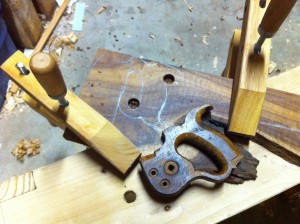

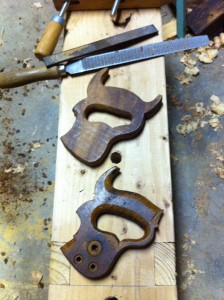
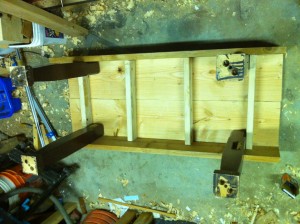
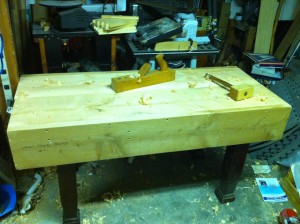


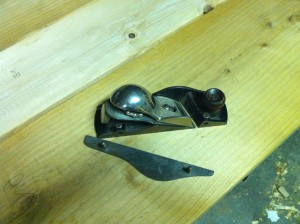
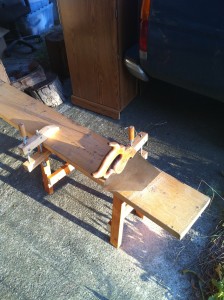
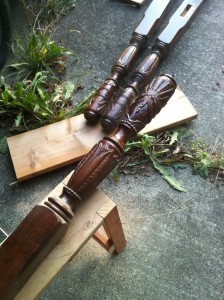
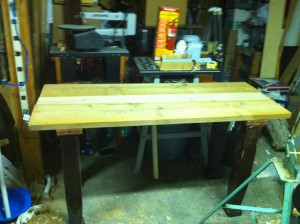


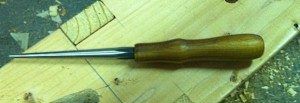


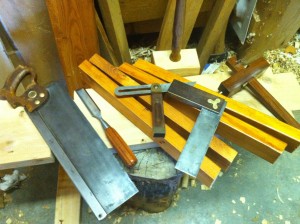
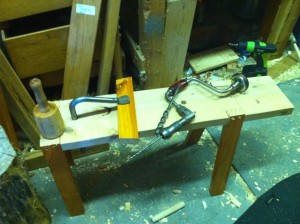



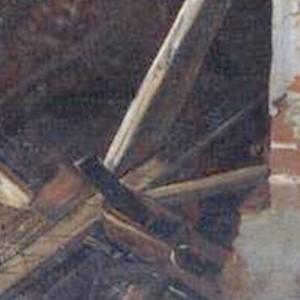
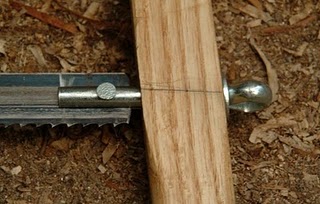


You must be logged in to post a comment.